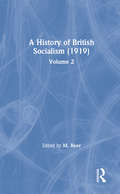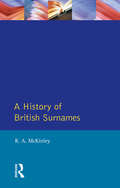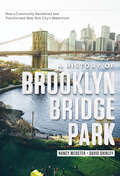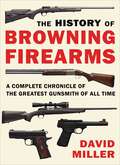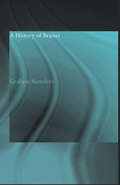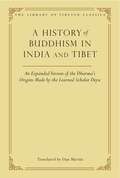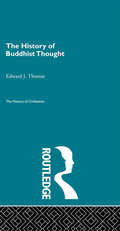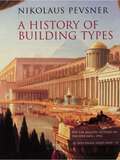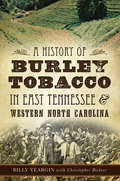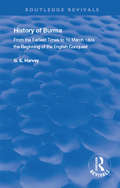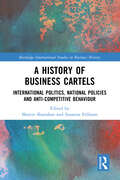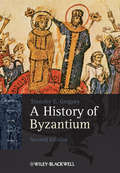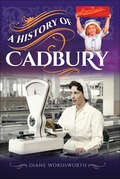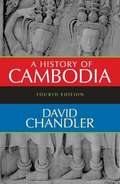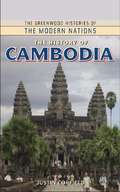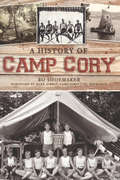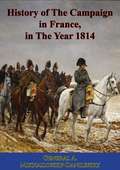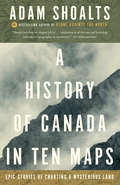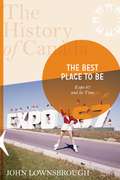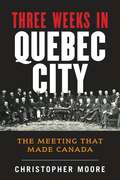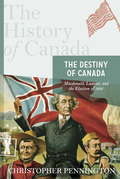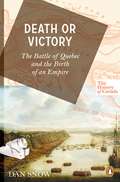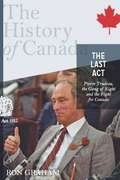- Table View
- List View
A History of British Socialism: Volume 2 (Routledge Library Of British Political History Ser.)
by M. BeerThis is volume 2 of the set A History of British Socialism. These volumes study the political thought experienced as a result of the massive transition of the British countryside to capitalist agriculture and capitalist industry.
A History of British Surnames (Approaches to Local History)
by Richard MckinleyAiming to avoid technical terminology, Richard McKinley provides an introduction to the history of hereditary surnames in Britain from their first appearance to the present day. Devoting a chapter to each of the main categories of name, he enables readers to set the facts they discover about their own ancestry, family history and surnames into the context of general surname development. The author deals with those names that originate in England, Wales and Scotland; and since these tend to have their own distinct histories, he discusses developments in each of the three countries separately, wherever appropriate. The book uses the study of surnames to illuminate social history and draws attention to the complex patterns of population mobility that have always characterized British Society. It also describes regional and class differences in surnames, some features of which survive to our own time.
A History of Brooklyn Bridge Park: How a Community Reclaimed and Transformed New York City's Waterfront
by David Shirley Nancy WebsterBy the 1970’s, the Brooklyn piers had become a wasteland on the New York City waterfront. Today they are a stunning park that is enjoyed by countless Brooklynites and visitors from around the world. A History of Brooklyn Bridge Park recounts the grassroots, multi-voiced, and contentious effort to transform Brooklyn’s defunct piers in the mid-1980s into a beautiful, conscientiously designed park. The movement to resist commercial development on the pier sprang up spontaneously but reveals how concerned citizens came together to shape the future of their community. After winning a number of battles, park advocates collaborated to create a thoroughly unique city park that took advantage of the water and the city’s skyline, incorporating a stunning design with vibrant cultural programming.From start to finish, this history emphasizes the contributions, collaborations, and spirited disagreements that made the planning and construction of Brooklyn Bridge Park a model of natural urban development and public-private partnership. The book includes interviews with Brooklyn residents, politicians, activists, urban planners, and other key participants in the fight for the park. The story of Brooklyn Bridge Park also speaks to larger issues confronting all cities, including the development of postindustrial spaces and how to balance public and private interests without sacrificing creative vision or sustainable goals.
A History of Brooklyn Bridge Park: How a Community Reclaimed and Transformed New York City's Waterfront
by Nancy Webster David ShirleyBy the 1970s, the Brooklyn piers had become a wasteland on the New York City waterfront. Today, they have been transformed into a stunning park that is enjoyed by countless Brooklynites and visitors from across New York City and around the world. A History of Brooklyn Bridge Park recounts the grassroots, multivoiced, and contentious effort, beginning in the 1980s, to transform Brooklyn's defunct piers into a beautiful, urban oasis. The movement to resist commercial development on the piers reveals how concerned citizens came together to shape the future of their community. After winning a number of battles, park advocates, stakeholders, and government officials collaborated to create a thoroughly unique city park that takes advantage of the water and the 'Manhattan skyline, combining an innovative design with vibrant cultural programming. From start to finish, this history emphasizes the contributions, collaborations, and spirited disagreements that made the planning and construction of Brooklyn Bridge Park a model of natural urban development and public–private partnership. The book includes interviews with Brooklyn residents, politicians, activists, urban planners, landscape architects, and other key participants in the fight for the park. The story of Brooklyn Bridge Park also speaks to larger issues confronting all cities, including the development of postindustrial spaces and the ways to balance public and private interests without sacrificing creative vision or sustainable goals.
The History of Browning Firearms: A Complete Chronicle of the Greatest Gunsmith of All Time
by David MillerA captivating and wonderfully illustrated chronicle of one of the most influential and legendary names in gunsmithing history. John M. Browning was born in Ogden, Utah, in 1855, into a world of gunsmithing. His father was a gunsmith who was already well known for a number of innovations in the field. As a young boy, John spent hours in his father's shop and allegedly knew the name of every part of a gun before he could read. It's hardly surprising that at age twenty-three, he was filing his first patent for the "J. M. Browning Single-Shot Rifle." Browning inherited his father&’s gun making shop, and with funds of less than a thousand dollars, developed it into a highly successful business that developed several iconic firearms including the Colt Peacemaker. Browning also cooperated with Winchester to develop a whole range of small arms including semi-automatic pistols, single-shot rifles, repeater rifles, and machine guns. His enthusiasm and creativity have led many to believe he is the greatest firearm designer of all time. This fascinating book describes the Browning history, and in addition to covering the full range of inventions and designs, also shows various gun-making artifacts, copies of designers' drawings, and interesting photographs of the weapons in the hands of users. The History of Browning Firearms makes a perfect addition to the libraries of Wild West buffs and firearms enthusiasts.
A History of Brunei
by Graham SaundersThe only full-length study of the Brunei Sultanate from the earliest times to the present. First published in 1994 and a sell-out success, RoutledgeCurzon is pleased to present this new edition, updated to the present. Saunders skilfully elucidates historiographical controversies over important events, persons and developments in Brunei's past which are still important issues in defining Brunei's identity and its political and social systems today. These controversies, over the antecedents of the Sultanate, the date of the conversion to Islam, the reigns of the early sultans, early contacts with Europeans and others, retain their relevance. Newly presented are interpretations of events since 1945 during the transition from protected state to full independence, and thence to the present Malay Islamic Monarchy.
A History of Buddhism in India and Tibet: An Expanded Version of the Dharma's Origins Made by the Learned Scholar Deyu (Library of Tibetan Classics #32)
by Dan MartinThe first complete English translation of an important thirteenth-century history that sheds light on Tibet&’s imperial past and on the transmission of the Buddhadharma into Central Asia.Translated here into English for the first time in its entirety by perhaps the foremost living expert on Tibetan histories, this engaging translation, along with its ample annotation, is a must-have for serious readers and scholars of Buddhist studies. In this history, discover the first extensive biography of the Buddha composed in the Tibetan language, along with an account of subsequent Indian Buddhist history, particularly the writing of Buddhist treatises. The story then moves to Tibet, with an emphasis on the rulers of the Tibetan empire, the translators of Buddhist texts, and the lineages that transmitted doctrine and meditative practice. It concludes with an account of the demise of the monastic order followed by a look forward to the advent of the future Buddha Maitreya. The composer of this remarkably ecumenical Buddhist history compiled some of the most important early sources on the Tibetan imperial period preserved in his time, and his work may be the best record we have of those sources today. Dan Martin has rendered the richness of this history an accessible part of the world&’s literary heritage.
The History of Buddhist Thought (The\history Of Civilization Ser.)
by Edward J. ThomasOriginally published between 1920-70,The History of Civilization was a landmark in early twentieth century publishing. It was published at a formative time within the social sciences, and during a period of decisive historical discovery. The aim of the general editor, C.K. Ogden, was to summarize the most up-to-date findings and theories of historians, anthropologists, archaeologists and sociologists. This reprinted material is available as a set or in the following groupings, or as individual volumes: * Prehistory and Historical Ethnography Set of 12: 0-415-15611-4: £800.00 * Greek Civilization Set of 7: 0-415-15612-2: £450.00 * Roman Civilization Set of 6: 0-415-15613-0: £400.00 * Eastern Civilizations Set of 10: 0-415-15614-9: £650.00 * Judaeo-Christian Civilization Set of 4: 0-415-15615-7: £250.00 * European Civilization Set of 11: 0-415-15616-5: £700.00
A History of Building Types (The A. W. Mellon Lectures in the Fine Arts #19)
by Nikolaus PevsnerAn essential guide to vital and often overlooked features of the architectural and social inheritance of the WestThis book provides vital insights into the ways in which architecture reflects the character of society. Drawing on his immense erudition and keenly discerning eye, Nikolaus Pevsner describes twenty types of buildings ranging from the most monumental to the least, and from the ideal to the most utilitarian. He covers both European and American architecture, with examples chosen largely from the nineteenth century, the crucial period for diversification. Included are national monuments, libraries, theaters, hospitals, prisons, factories, hotels, and many other public buildings. Incisive and authoritative, A History of Building Types traces the evolution of each type in response to social and architectural change, and discusses differing attitudes toward function, materials, and style.Please note: All images in this ebook are presented in black and white and have been reduced.
A History of Burley Tobacco in East Tennessee & Western North Carolina
by Billy Yeargin Christopher BickersBurley tobacco revolutionized the industry in east Tennessee and western North Carolina. What started from two farmers planting white burley in Greeneville ignited an agricultural revolution and significantly changed crops, production and quality. Burley transformed the tobacco industry with new cultivation techniques and a shift from dark and flue-cured tobacco. By the 1990s, burley tobacco production in the region had drastically declined, and it is a tradition that few local farmers still practice. Agricultural experts Billy Yeargin and Christopher Bickers take a nostalgic look at the historic rise of burley tobacco and its gradual decline.
History of Burma: From the Earliest Times to 10 March 1824 The Beginning of the English Conquest (Routledge Revivals)
by G. E. HarveyOriginally published in 1983, this book explores the history of Burma, including chapters on Burma before 1044, The Kingdom of Pagan and the Shan Dominion. Burma's history had been little studied until recently, until the Burma Research Socety, founded in 1910, began to collect material of all kinds, and this book may be regarded therefore as one of the first-fruits. The book presents a mass of original work and incorporates the results of research up to the date of going to press; it offers a flood of light on the still many dark places of Burmese history and constitutes distinctly a step forward in our knowledge of the subject.
A History of Business Cartels: International Politics, National Policies and Anti-Competitive Behaviour (Routledge International Studies in Business History)
by Martin ShanahanInternational cartels are powerful organizations that impact our everyday lives, although they are little known. This book presents 15 historical case studies of international cartels that include agricultural and mineral commodities, the machinery industry, telephone equipment, whiskey and cement. These cases reveal that international cartels manipulated prices and shared markets over many decades but that their real impact was far wider. The global convergence towards criminalizing serious cartel conduct has seen a revival in historical research on cartels and competition policy. The regulation of anti-competitive behaviour has changed over time. To understand why the US, European and other modern economies altered their policies through the 20th century, it is critical to understand when, how and why governments have interacted with, and been influenced by, business organizations such as cartels. This volume draws together researchers from different nations to examine the impact of international cartels on the experience of individual nations, those nations’ interactions with one or more international cartels, and ultimately the interactions of individual nations with the wider international community. This book will be of interest to researchers, academics and advanced students in the fields of business and economic history, political economy, and government policy, as well as those interested in cartels and their impact on the wider economy.
A History of Byzantium (Blackwell History of the Ancient World #14)
by Timothy E. GregoryThis revised and expanded edition of the widely-praised A History of Byzantium covers the time of Constantine the Great in AD 306 to the fall of Constantinople in 1453. Expands treatment of the middle and later Byzantine periods, incorporating new archaeological evidence Includes additional maps and photographs, and a newly annotated, updated bibliography Incorporates a new section on web resources for Byzantium studies Demonstrates that Byzantium was important in its own right but also served as a bridge between East and West and ancient and modern society Situates Byzantium in its broader historical context with a new comparative timeline and textboxes
A History of Cadbury
by Diane WordsworthWhen John Cadbury came to Birmingham in 1824, he sold tea, coffee and drinking chocolate in a small shop on Bull Street. Drinking chocolate was considered a healthy alternative to alcohol, something Cadbury, a Quaker, was keen to encourage.In 1879, the Cadburys moved to Bournville and created their factory in a garden an unprecedented move. It is now ironic that todays Bournville is surrounded by that urban sprawl the Cadburys were so keen to get away from.This book looks at some of the social impact this company has had since its inception, both on the chocolate and cocoa business in general and on the community at large, both within and without the firm of Cadbury.In 2024, Cadbury's will be celebrating 200 years of the first store opening. This is the story of how the company began, how it grew, and how they diversified in order to survive.
A History of Cambodia
by David ChandlerIn this clear and concise volume, author David Chandler provides a timely overview of Cambodia, a small but increasingly visible Southeast Asian nation. Praised by the Journal of Asian Studies as an "original contribution, superior to any other existing work," this acclaimed text has now been completely revised and updated to include material examining the early history of Cambodia, whose famous Angkorean ruins now attract more than one million tourists each year, the death of Pol Pot, and the revolution and final collapse of the Khmer Rouge. The fourth edition reflects recent research by major scholars as well as Chandler's long immersion in the subject and contains an entirely new section on the challenges facing Cambodia today, including an analysis of the current state of politics and sociology and the increasing pressures of globalization. This comprehensive overview of Cambodia will illuminate, for undergraduate students as well as general readers, the history and contemporary politics of a country long misunderstood.
The History Of Cambodia
by Justin CorfieldThis reference for students and general readers overviews the history of Cambodia, from the fall of Angkor and the French Protectorate period (1432-1863) to the present. More than half of the book is dedicated to the period from 1970 through the present, with chapters on the Khmer Republic, Democratic Kampuchea, the second civil war, the road to democracy, and Cambodia under Hun Sen. An introductory chapter overviews the country's geography, political institutions, economy, and culture. The book includes b&w historical and contemporary photos, a chronology, profiles of key figures, and a list of acronyms. Corfield teaches history and international relations at Geelong Grammar School, UK. Annotation c2010 Book News, Inc., Portland, OR (booknews.com)
A History of Camp Cory
by Mark Dibble Bo ShoemakerSummertime memories of Camp Cory are awash in warm emotion. From the Reveille bugle at first light to Taps in the evening, those days were the absolute best. Skippering a K-boat on cool Keuka Lake. Silly songs and skits performed into the night. The boundless nature of genuine friendship. It is hard to explain exactly why that time is so special, how it changes lives forever. This wonderful mystery is revealed here by official Camp Cory historian Bo Shoemaker. So gather around the campfire to reminisce. Just be sure to watch out for the H Man!
History of The Campaign in France, in The Year 1814
by General A. Mikhailofsky-DanilefskyA fascinating account of the 1814 campaign in France which dealt the final blow to Napoleon's first reign as Emperor of the French."THE original Work, from which the present volume has been translated, was published in St. Petersburg during the latter part of the year 1836. The Author, a well-known Russian General, is now a Member of the Imperial Senate. During the eventful campaign of 1814, he served as Aide-de-camp to the Emperor Alexander, and was constantly at His Majesty's headquarters, where he was employed in wielding both the sword and the pen."-Introduction
A History of Canada in Ten Maps: Epic Stories of Charting a Mysterious Land
by Adam ShoaltsThe sweeping, epic story of the mysterious land that came to be called “Canada” like it’s never been told before. Every map tells a story. And every map has a purpose--it invites us to go somewhere we've never been. It’s an account of what we know, but also a trace of what we long for. Ten Maps conjures the world as it appeared to those who were called upon to map it. What would the new world look like to wandering Vikings, who thought they had drifted into a land of mythical creatures, or Samuel de Champlain, who had no idea of the vastness of the landmass just beyond the treeline? Adam Shoalts, one of Canada’s foremost explorers, tells the stories behind these centuries old maps, and how they came to shape what became “Canada.” It’s a story that will surprise readers, and reveal the Canada we never knew was hidden. It brings to life the characters and the bloody disputes that forged our history, by showing us what the world looked like before it entered the history books. Combining storytelling, cartography, geography, archaeology and of course history, this book shows us Canada in a way we've never seen it before.
History Of Canada Series: The Best Place To Be,The
by John LownsbroughA pivotal event in Canada's history For six months in 1967, from late April until the end of October, Canada and its world's fair, Expo 67, became the focus of national and international attention in a way the country and its people had rarely experienced. Expo 67 crystallized the buoyant mood and newfound sense of confidence many felt during Canada's centennial. It becomes clearer, though, as its forty-fifth anniversary approaches in spring 2012, that Expo was something more than just a great world's fair. For many Canadians, it became a touchstone, a popular event that penetrated the collective psyche. The Best Place to Be takes a look at Expo and at the social and political contexts in which it occurred. It is above all a story of people: the young men and women who worked at Expo, the visitors, and the cameo appearances from the titled and celebrated, such as Elizabeth II, President Lyndon Johnson, President Charles de Gaulle (whose visit to Expo and Montreal became infamous), U.S. Senator Robert F. Kennedy, Jacqueline Kennedy, Princess Grace of Monaco, Princess Margaret, Marshall McLuhan, Sidney Poitier, Laurence Olivier, Cary Grant, Twiggy, and Pierre Trudeau.
The History of Canada Series: Three Weeks in Quebec City
by Christopher MooreIn 1864, thirty-three delegates from five provincial legislatures came to Quebec City to pursue the idea of uniting all the provinces of British North America. The American Civil War, not yet over, encouraged the small and barely defended provinces to consider uniting for mutual protection. But there were other factors: the rapid expansion of railways and steamships spurred visions of a continent-spanning new nation. Federation, in principle, had been agreed on at the Charlottetown conference, but now it was time to debate the difficult issues of how a new nation would be formed. The delegates included John A. Macdonald, George Etienne-Cartier, and George Brown. Historian Christopher Moore demonstrates that Macdonald, the future prime minister, surprisingly was not the most significant player here, and Canada could have become a very different place. The significance of this conference is played out in Canadian news each day. The main point of contention at the time was the issue of power--a strong federal body versus stronger provincial rights. Because of this conference, we have an elected House of Commons, an appointed Senate, a federal Parliament, and provincial legislatures. We have what amounts to a Canadian system of checks and balances. Did it work then, and does it work now?
History Of Canada Series: The Destiny Of Canada,The
by Christopher PenningtonIt was Sir John A. Macdonald's last campaign. His Conservatives had dominated Canadian politics since Confederation. Their National Policy, which protected Canadian manufacturers from foreign competition, was well established and affection for the "Old Man" was deep and widespread. The Liberal leader, Wilfrid Laurier, was new in the job and uncertain that a Roman Catholic from Quebec had any chance of winning votes outside his home province. But Macdonald's decision to hang Louis Riel had split the country, the economy was in the doldrums, and a movement in support of free trade with the United States gave the Liberals hope. In this richly textured narrative, Christopher Pennington spins a colourful tale of a country poised to make a momentous choice and of nineteenth century politics both at its most principled and at its most corrupt.
The History of Canada Series: The Battle For Quebec And The Birth Of An Empire
by Dan SnowPerched atop a tall promontory and surrounded on three sides by the treacherous St. Lawrence River, Quebec City forms an almost impregnable natural fortress. But in 1759, with the Seven Years War raging around the globe, the capital city of New France came under attack. With the irascible British general James Wolfe in command, a force of more than 100 ships carrying nearly 9,000 men navigated the river, scaled the cliffs, and laid siege to the town in an audacious attempt to expel the French from North America forever. It would be a brutal battle, with British soldiers confronting the troops commanded by the French general, the marquis de Montcalm. They were on unfamiliar terrain and facing extreme weather, a colonial militia, and experienced First Nations warriors. Using original research and multiple perspectives, Dan Snow grippingly describes the events that would reshape North America and, eventually, change the British Empire forever. Death or Victory is history--military, political and human history--told on an epic and thrilling scale.
History Of Canada Series-the Last Act:pierre Trudeau,The
by Ron GrahamBetween the morning of Wednesday, November 4, and the morning of Thursday, November 5, 1981, a fateful drama unfolded that changed Canada forever. In one last attempt to renew the constitution with the consent of the provinces, Prime Minister Pierre Elliott Trudeau met behind closed doors in Ottawa with the ten premiers. It was the culmination of more than five decades of constitutional wrangling, and has been called the most important conference since the Fathers of Confederation got together in Quebec City in 1864. Faced with the threat of Quebec independence, the ambitions of Western Canada, and the provinces' demands for more power, Trudeau was embattled. But he was fiercely determined to make Canadians fully independent and to entrench a Charter of Rights and Freedoms. What happened that day still reverberates. It severed the last important link to Canada's colonial past. It guaranteed individual liberty and minority rights in the future. It weakened the grip of the elites and gave ownership of the constitution to Canadians. But it came at a price. Quebec alone refused to sign the final deal. René Lévesque, its separatist premier, claimed he had been betrayed by his allies in the Gang of Eight. The legend of the "Night of the Long Knives" took hold, precipitating a series of events that came close to destroying the country. Thirty years later, author Ron Graham delivers a gripping account of the fractious debates and secret negotiations. He uses newly uncovered documents and the candid recollections of many of the key participants to create a vivid record of that momentous twenty-four hours. Authoritative and engaging, The Last Act is a remarkable combination of scholarly research and historical narrative.
